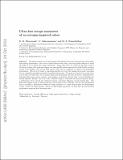Ultra-fast escape maneuver of an octopus-inspired robot
Author(s)
Triantafyllou, Michael S.; Weymouth, G. D.; Subramaniam, V.
DownloadTriantafyllou_Ultra-fast escape.pdf (2.793Mb)
OPEN_ACCESS_POLICY
Open Access Policy
Creative Commons Attribution-Noncommercial-Share Alike
Terms of use
Metadata
Show full item recordAbstract
We design and test an octopus-inspired flexible hull robot that demonstrates outstanding fast-starting performance. The robot is hyper-inflated with water, and then rapidly deflates to expel the fluid so as to power the escape maneuver. Using this robot we verify for the first time in laboratory testing that rapid size-change can substantially reduce separation in bluff bodies traveling several body lengths, and recover fluid energy which can be employed to improve the propulsive performance. The robot is found to experience speeds over ten body lengths per second, exceeding that of a similarly propelled optimally streamlined rigid rocket. The peak net thrust force on the robot is more than 2.6 times that on an optimal rigid body performing the same maneuver, experimentally demonstrating large energy recovery and enabling acceleration greater than 14 body lengths per second squared. Finally, over 53% of the available energy is converted into payload kinetic energy, a performance that exceeds the estimated energy conversion efficiency of fast-starting fish. The Reynolds number based on final speed and robot length is Re ≈ 700 000. We use the experimental data to establish a fundamental deflation scaling parameter σ* which characterizes the mechanisms of flow control via shape change. Based on this scaling parameter, we find that the fast-starting performance improves with increasing size.
Date issued
2015-02Department
Massachusetts Institute of Technology. Center for Ocean Engineering; Massachusetts Institute of Technology. Department of Mechanical EngineeringJournal
Bioinspiration & Biomimetics
Publisher
IOP Publishing
Citation
Weymouth, G D, V Subramaniam, and M S Triantafyllou. “Ultra-Fast Escape Maneuver of an Octopus-Inspired Robot.” Bioinspiration & Biomimetics 10, no. 1 (February 1, 2015): 016016.
Version: Original manuscript
ISSN
1748-3190
1748-3182